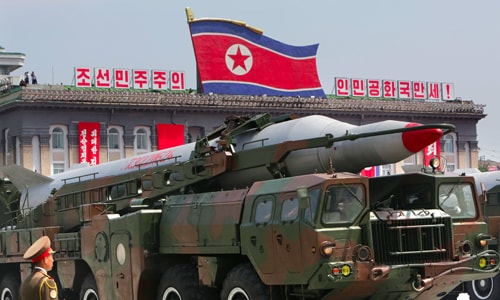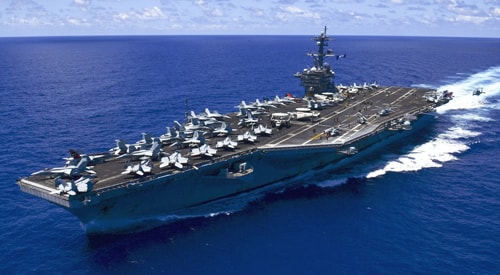Situations in which North Korea could wield the 'nuclear sword'
North Korea's leadership would be ready to use nuclear weapons whenever it felt its nation's survival was threatened.
 |
In recent days, despite great pressure from the US and its ally China, North Korea has still declared that it will continue its 6th nuclear test. According to commentator Ryan Pickrell of National Interest, this view of North Korea comes from the belief of the top leaders in Pyongyang that nuclear weapons are the only thing that can ensure the country's survival.
Pyongyang has said it fears no one and will defeat the US and its allies with its “nuclear treasure sword”. According to Pickrell, behind this strong statement from North Korea is a deep fear that it will be destroyed by the US and its strategic partners one day. Faced with an uncertain future, North Korea believes that the only long-term solution is to develop nuclear weapons.
As supreme leader, Kim Jong-un has the final say on whether North Korea will launch a nuclear attack on another country. “I think Kim Jong-un will press the button if he thinks his power and regime are threatened,” said Thae Yong-ho, a North Korean defector. “He can do anything.”
"From North Korea's perspective, they see themselves as facing the world's largest military and nuclear power in a potential conflict. So pursuing nuclear weapons is a deterrent to offset their military inferiority," explained Rodger Baker, vice president of Stratfor.
Pyongyang's calculation when holding the "nuclear sword" in its hands is to "prevent the US from gathering forces around North Korea, protecting this country from the same fate as Iraq," said Joshua Pollack, an expert at the James Martin Center for Nonproliferation Studies at the Middlebury Institute of International Studies.
Kim Jong-un would decide to wield this sword in the event of an imminent conflict, or if some external force posed an immediate threat to North Korea’s survival. Views on what constitutes a “swinging sword” vary widely, making it difficult to predict North Korea’s actions.
"For example, we don't know for sure whether North Korea would consider a limited airstrike on its nuclear or missile facilities to be an immediate threat, or whether its initial response would be with conventional weapons systems," Baker commented.
"However, given the disparity in military power between the US and North Korea, even a limited US airstrike could be seen by Pyongyang as the start of a larger military campaign, forcing them to quickly use nuclear weapons, or else their response capabilities would be neutralized," the expert said.
The most dangerous period
According to George Friedman, president of the international analysis organization Geopolitical Futures, North Korea developed its nuclear program to use it as a bargaining tool, and nuclear weapons would be an effective deterrent against any foreign power seeking to overthrow its government.
But the most dangerous phase for North Korea is when it is close to having a reliable nuclear weapon, but has not yet achieved it. This is when a preemptive strike by the US and its allies is most likely to occur.
At this stage, North Korea cannot counterattack with nuclear weapons. Pyongyang's deliberate messaging that it possesses nuclear weapons only adds to the urgency of a preemptive strike.
A strike would be considered by the US based on the severity of the consequences of a North Korean nuclear retaliation. In the event the US believes North Korea does not yet possess nuclear weapons, the decision would be based on the likelihood that Pyongyang is close to developing such weapons of mass destruction.
 |
A US Navy nuclear aircraft carrier. Photo: USNI |
The problem is that the US president will have to rely on intelligence to assess how close North Korea is to nuclear weapons. US intelligence has little information to make a firm assessment, while President Donald Trump has expressed skepticism about the intelligence community.
The US must also consider the damage that non-nuclear weapons systems, especially the thousands of long-range artillery pieces of North Korea, could cause to its ally South Korea in the event of a preemptive strike. North Korea possesses more than 21,000 artillery pieces of various types, which could rain down about half a million shells on the South Korean capital Seoul, turning the country's most populous and bustling metropolis into a wasteland.
According to Friedman, North Korea knows that the United States will never trade its ally, South Korea, for its nuclear weapons program, so it will still be determined to develop its nuclear weapons program, despite Washington's threats to use force.
Observers say that for these reasons, world leaders will have to face the thorny question of the North Korean nuclear issue for decades to come, while Pyongyang's nuclear and ballistic missile capabilities will improve day by day, although the possibility of the country launching a first attack is very low.
"There is currently no way to stop North Korea from advancing its nuclear capabilities," said Jeffrey Lewis, director of the James Martin Center for Nonproliferation Studies at the Middlebury Institute of International Studies. "It is clear that Pyongyang has found a way to ensure the world negotiates with it."
According to Vietnamnet.vn
| RELATED NEWS |
|---|






